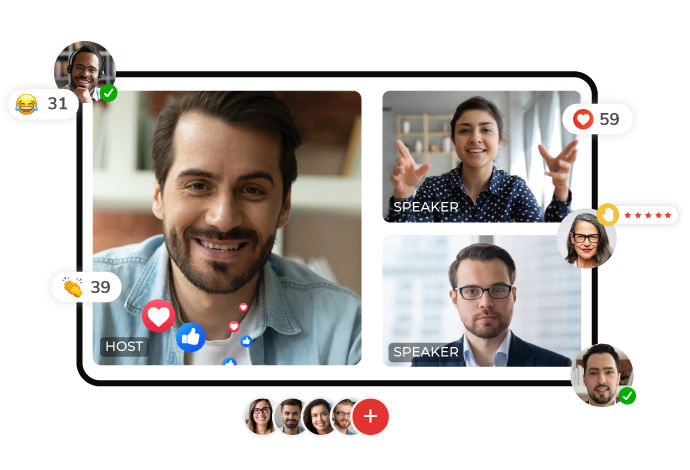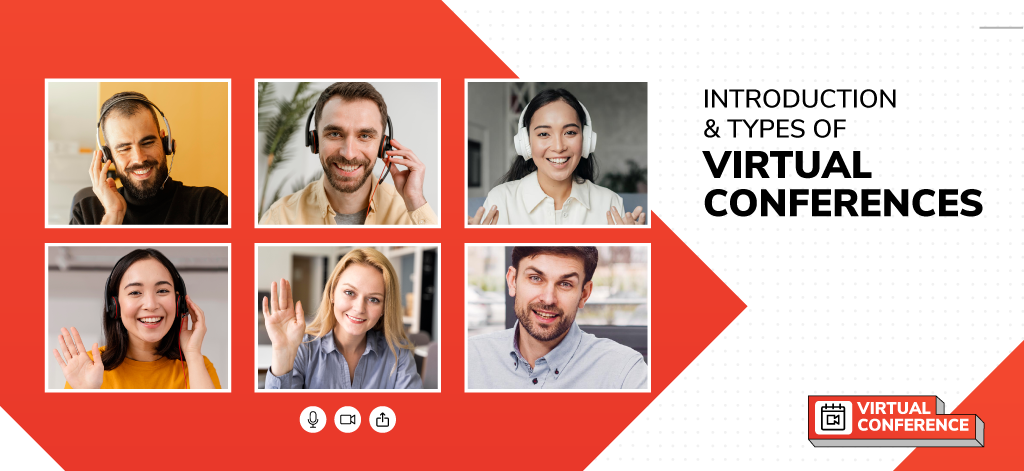The event industry was one of those sectors that got majorly affected when the pandemic hit the world. But thanks to virtual events and virtual events platforms that came to their rescue. The adoption of virtual venues has made annual conferences, meetings, and summits not just possible but a lucrative affair too.
Wondering about how a virtual conference works? Let us walk you through a step-by-step guide that can help you plan a successful virtual conference.
Table of Contents
What is a Virtual Conference?
A virtual conference is an engaging event that happens online over the Internet bringing together a wide range of people across the globe who share mutual niche interests or experiences. A virtual conference is quite different than a virtual meeting.
Like physical conferences, virtual conferences also include keynote sessions, panel discussions, breakout sessions, training & certification, educational sessions, and many more.
The goal of virtual conferences is qualified lead generation, brand awareness, and enhanced global reach.
How Do You Build a Virtual Conference Strategy?
A virtual conference is very dissimilar to an in-person conference. It happens online over a secure virtual event platform and expects attendees to concentrate on the screen for long hours.

Hence, this is why the content of your conference should be super engaging to keep the attendees involved and interested throughout the conference. It should include an eye-catching design, strategic creation, and management of the content – on multiple websites, social media channels, newsletters, and everywhere else that can help you target your audience and spread the word.
Creating compelling content plays an important role in grabbing the attention of global delegates, thus leading to more registrations. A powerful content strategy is essential for encouraging, notifying, and boosting awareness about your brand and its prestige as a knowledgeable leader in the industry.

Why Should You Host a Virtual Conference?
The outbreak of the global pandemic endangered various businesses and standard processes for different entities across the globe. Multiple annual conferences, AGMs, and summits pivoted to the virtual space during this time. While this transformation poses numerous challenges, it also proposes unique opportunities for event planners, even during a pandemic.
The following section notes down the advantages and reasons for you to plan a virtual conference in 2021.
1. Increased Attendee Count and Better Reach
The virtual conference allows attendees across the globe to participate and access the event remotely over the Internet using a compatible laptop or smartphone. Amid several travel restrictions and lockdown impositions, going virtual has proved to be a great success for several conferences, meetings, summits, and town halls. Online conferences let you target a wider audience residing in different parts of the world.
2. Saves Your Time and Money
Planning a virtual conference or any other virtual event is a cost-effective process. The hurdles of hiring a venue, providing accommodation, arranging food and meals get completely eliminated with online conferences. Besides this, a virtual conference platform is backed by 24/7 tech support to troubleshoot connectivity issues and offer assistance to the attendees if required.
During a virtual conference, you may also be able to invite incredible speakers who would not have been able to attend your in-person conference due to time and travel concerns. Inviting them for a short video call is a schedule-friendly method to make your conference even more interactive.
3. Evergreen Content
It is indeed the best part! The videos, images, recordings, and documents of your online conferences can be used as valuable resources to market your upcoming event.
4. Easy to Obtain Data and Analytics
It is vital to stay a step ahead of your competitors. For this, look for an all-in-one virtual conference software that is secure and can help you with complete attendee navigation data. Comprehensive data helps you gauge the success of your virtual conference and make significant improvements for future events if required.
5. Better Networking Options
Virtual event platforms offer numerous features to connect and interact with other attendees. Features like AI-based recommendations, business card exchange, B2B meetings scheduler, virtual networking tables, live chat functionality help you engage with speakers and other attendees during the event.
6. Prompt Feedback and Lead Generation
Sessions of virtual conferences are usually followed by surveys, live polls, and Q&A rounds to facilitate real-time 2-way interactions. With conferences happening virtually, it is a more precise way of understanding your attendee’s interests, concerns, and feedback. Besides, this is also an effective strategy to promote engagement and obtain more leads at an online conference.
Virtual conferences eliminate the need for brochures thus, leading to lesser paper disposal. With a reduction in carbon footprint and less emission of gases, you can contribute your share towards making this world a better place.
Features of Virtual Conference
A unique aspect of virtual events is customization. Therefore, it is vital to look for a virtual venue that can customize the interface based on your business needs.
You can include a lobby, engagement zones, exhibit halls, networking lounges, auditoriums, and theaters to deliver unique and bizarre experiences to the audience.
If you are looking for some exceptional virtual conference platforms, then Dreamcast, zoom, and Google’s Meet are some excellent choices.

2. Automation
Choose effective virtual conference platforms that are convenient to set up and navigate. To save more time, it is vital to include automation in your platform. You can request a demo and ask your virtual event provider a few questions regarding the tour of the backend, the access control feature, and if there’s a possibility of making changes on the backend by the exhibitor.
3.Live-streaming and Recording
Live interactions are a major aspect of virtual conferences. The intend is to promote 2-way communications on a real-time basis. Live polls, surveys, Q&A sessions are some exciting features of a perfect virtual conference software that allow the attendees, exhibitors, and speakers to connect seamlessly. Live video streaming allows the speakers to live stream their discussions, answer questions, and interact via live chats with the attendees.
4.Social Media Integration
Social media promotion has an important role in promoting a virtual conference. It is possible to enhance the global reach of your online conference with a decisive social media promotion. You can use different social media channels like Facebook, Instagram, Twitter, or LinkedIn to post conference-specific videos, images, and updates to spread awareness about your event.
5. Sponsorship
Sponsors can finance your virtual conference, making them more acceptable. They can be a valuable asset in promoting your virtual conference and increasing its ROI. Brand ventures and sponsorships are essential for offering a value-yielding virtual conference.
6. Customer Support
During virtual conferences, there might be connectivity problems, sign-in issues, and other concerns. Hence, the ability to offer immediate assistance or troubleshooting option should be an important feature of your virtual platform. Virtual conference software that concentrates on offering exceptional customer care is feasible to work with. The 24/7 customer and technical support features come to your rescue in case of any urgency during a live virtual conference.
7. Data and Analytics
One of the main advantages, why virtual conferences outrun physical conferences, is detailed insights. A robust virtual conference platform allows the host to obtain relevant information about the audience and their interactions with different innovations provided in the virtual conference. With comprehensive data, it becomes easier to gauge the success of an event.
8. Valuable Feedback and Growth
Lastly, another most vital feature of a virtual conference venue is feedback. You can send simple survey emails to collect the valuable data of the attendees. It is an effective way to make relevant changes for hosting even better and successful virtual conferences.

How To Host a Successful Virtual Conference?
The event industry is expanding! Hence, this is why it becomes more vital than ever to include unique and interactive elements to make your event unique and realistic. Virtual conferences aim to let attendees learn, connect, and interact just like they did during physical conferences.
If you are new to the virtual world, here are a few steps that can guide you through;
Step 1: Determine the goals
Before you begin with the planning, be sure with your objectives of hosting the virtual conference. How do you wish to accomplish your goals from this conference? What will be the Agenda of your Virtual Conference? Which KPIs will help you gauge the success of your event?
The answer to these questions will create a roadmap and guide you on what appropriate measures you should take.
Step 2: Begin with a strategic plan
Once the intentions of conducting a virtual conference are clear, move ahead with virtual conference planning and strategy. Begin with a fruitful plan to ensure the success of your Online Conference. Ask a few questions to yourself:
- Do you want your Virtual Conference to be live, on-demand, or both?
- Will your online conference be chargeable?
- How do you want to keep the registration process?
- How will the participants connect with other attendees at your virtual conference?
- What engaging features do you want at your event?
- How will your attendees access the virtual conference?
- What networking opportunities will you include at your event?
- How will you measure the KPIs of the conference?
These are some of the vital questions that can help you plan unique and realistic virtual conferences.
Besides this, it is also important to understand your target audience and their expectations. To host a virtual conference that can witness more attendees, make sure to do your research and identify the industry trends in order to host an interactive conference.
Step 3: Select an all-in-one virtual conference platform
The choice of virtual event technology is very important in determining the features and innovations you want to incorporate in your online conference. Look for a virtual conference platform that has a customizable interface, leverages the right event technology, includes excellent engaging tools and networking options to recreate the experiences of a physical conference.
Your virtual conference venue should also be capable of organizing live polls, Q&A sessions, surveys, games, a live chat feature to let the audience and exhibitors connect and interact seamlessly. It should also include a robust data trackability functionality that enables you to gauge the success of your event.
Step 4: Include incredible speakers
Once you have decided on the objectives and Agenda of your conference, the next step includes delivering your message rightly to the attendees. Hence, this is why it is essential to include noteworthy speakers who can keep the audience engaged with their content. Speakers or industry leaders who are experienced and well-versed in addressing a wide range of audiences can be great choices. Virtual conferences include speakers digitally therefore, do your best to get the incredible ones onboard.
Step 5: Make your virtual conference more engaging
Consider adding interactive features like virtual networking tables, business card exchange features, DIY booth builder, AI-based recommendations, B2B meetings scheduler to make your virtual conference even more successful and unique.
AI-based recommendation helps you with a list of attendees who share the same interest and concerns. It is an effective way to connect and interact at an online event. Attendees and exhibitors can decide on a mutual time to connect and communicate even after the conference is over, using the B2B meetings scheduler.
Consider employing pop-up features or push-up notifications to keep the audience notified about the prevailing and forthcoming sessions.
Remember to check if the content of your virtual conference is easily accessible by the attendees. Enable the participants to seamlessly download and share files, videos, audio, PDFs, documents, and other content at the Virtual Conference. Incorporate live polls, Q&A sessions, and surveys to encourage real-time interactions.
Besides, you can also create a 3D virtual environment to deliver impactful experiences. Right from a dynamic lobby, teleportation, animated light to GIFs. It is an excellent way to replicate the experiences of a physical conference.
Step 6: Promote your virtual conference
It is vital to make promising efforts to market your virtual conference to welcome more participation. Make the most of different social media channels like Twitter, Facebook, Instagram, and LinkedIn to spread awareness regarding your event. Use conference-specific hashtags to enhance the global reach of the conference.
Besides, create a compelling landing page with the date, time, and registration link of the conference to encourage participation.
You can also send periodic emails or practice email marketing to remind your potential attendees about the event.
Step 7: Perform a Dry-run
Lastly, it is vital to perform a test rehearsal to avoid the possibility of any sort of technical glitches. Perform several system checks, test the Internet connection, and system configurations to avoid any blunder on the D-day. Your platform should also be backed by 24/7 customer support to offer immediate assistance to the attendees in case of any sign-up or login issues.

How To Promote Networking and Engagement at a Virtual Conference?
Virtual conferences offer numerous opportunities for networking and engagement. While meetings and conferences are advantageous in terms of thickening vital business relationships, a successful virtual conference eliminates unnecessary steps, saves time and money, and allows audiences and sponsors to connect and interact seamlessly.
Here are some excellent features of a virtual conference that can make way for new connections;
1. Chatrooms
It is one of the most familiar tools to replicate an on-site conference experience. You can include a live chat feature, enabling both 1:1 and group discussions using the same platform.
It lets the attendees share their suggestions and ask relevant questions. Chatrooms allow attendees, speakers, and exhibitors to have common discussions, thus making way for new connections.
Live chat specialties can also be combined with audio and video to enhance the experience of the attendees and exhibitors.
2. Schedule Meetings
The ability of a virtual conference platform to let attendees and exhibitors plan a meeting post the event is exceptional. As an online conference participant, almost everyone looks for long-lasting connections. Dreamcast prioritizes this aspect and lets the audience use the B2B meetings scheduler to schedule meetings with the exhibitors to connect and interact after the conference is over.
3. Dynamic Lobby
Creating an immersive 3D lobby that showcases the logo, brand, content, products, and services of the sponsors is an effective way to obtain more leads and drive sustainable growth. Some organizations also attach their social media channel links in the lobby area. It is an excellent way of promoting your brand and reaching global delegates.
4. AI matchmaking
It is an effective tool to bring like-minded people together during an online conference. During Virtual Conferences, you cannot simply bump into each other, unlike physical events. Therefore, AI matchmaking helps you with the list of attendees who share common interests and concerns.
5. Gamification
Gamification is another way to promote engagement at a virtual conference. Games like tic-tac-toe, crosswords, word games, shooting games, etc help in keeping your attendees involved and hooked throughout the event. Adding a fun element in any event – be it physical, virtual, or hybrid always works well in delivering impactful experiences.
You can also include a leaderboard challenge to avoid the top 5 scorers with exciting gifts and prizes.
6. Other Exciting Features
To make your virtual conference more engaging, you can add features like a social wall, branded photo booths, and a signature wall. Everyone at an Online Conference would adore taking back remarkable experiences by taking photos in branded booths or penning down their loving memory on the social wall.
7. Live Polls, Surveys, and Q&A Sessions
It is vital to promote 2-way interaction during a virtual conference. Live polls, surveys, and Q&A sessions are effective tools to let attendees and exhibitors have real-time interactions. They can connect, interact, and get qualified leads more seamlessly. Also, keeping the attendees involved ensures that they enjoy the session and do not get distracted.

How to Measure the Success of Your Virtual Conference?
Hosting a conference virtually helps you obtain detailed and accurate data. This data and insights help you learn about features that worked, along with the ones that need to be avoided for forthcoming events.
1. Event Data
This is the fundamental data that explains the virtual conference itself. Conference type, expense, date, registration numbers, etc. are standards of event data. Obtaining accurate event or conference data enables you to gauge and estimate the performance or success of the conference.
2. Engagement Data
Engagement data of the virtual conference is very dynamic. It’s obtained after analyzing the attendee navigation throughout the event. It includes the count of downloaded content, most attended sessions, information shared by the attendees and exhibitors, most used features, etc.
3. User Experience and Satisfaction
You can assess this by asking your attendees to fill up simple forms or surveys post the virtual conference.
Real-time reports and meaningful analytics let you make significant improvements for the upcoming virtual events.
Wrapping Up
Virtual conference platforms play a vital role in elevating the level of your online conferences. Dreamcast is a feature-rich virtual platform that can help you conduct unique and successful Virtual Conferences.
Book a demo today!

Virtual Conference FAQs
What is a Virtual Conference?
A virtual conference is an event that happens over the Internet and a secure conference platform. It involves a large spectrum of global delegates who attend the event to learn, network, and connect.
These conferences include keynote sessions, panel discussions, networking lounges, and breakout rooms to let attendees and exhibitors have 2-way communication.
How can I ask questions during a Virtual Conference?
Virtual conference platforms can incorporate several features to let you ask questions or interact in real-time. It can be done through;
- Live chat feature
- Virtual networking tables
- Q&A sessions
What can I do at a Virtual Conference?
- Share and learn information about industry insights
- Connect with industry experts and fellow attendees in real-time
- Discuss problems and ideas that concentrate on a specific topic of mutual interest
Where will the virtual conference be held?
It happens online, over the Internet. You do not need to travel to a physical venue to participate in a virtual conference. You can access it from any compatible desktop, smartphone, and tablet.





















